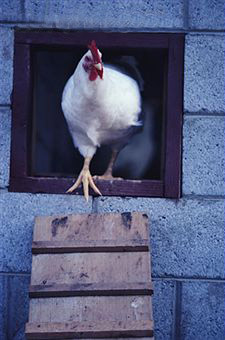Economic and Historic Roots of the DIY Movement
Why do you do it yourself? I do it because there are so many things I like that I’d get more satisfaction out of making it myself. I cook my own meals from scratch because it is cheaper and healthier. I learned my cooking skills from my grandma and don’t want to lose the knowledge I’ve gotten from her. I make minor alterations to men’s suits because it is a skill that I can make money with and provide a cheaper service for men I know. I intend on growing an herb garden this summer so I can have fresh basil and rosemary whenever I want it. I make pillowcases to brighten my living room for a quarter of the cost of buying a new throw pillow. I create my own holiday decorations because they often look better than the junky things sold these days at chain stores. These are reasons I do projects myself. Did you find themes in these projects? My family has a heritage and tradition that I want to keep up; I can save and make money from my skills, and I enjoy outcome and personal satisfaction from hands-on projects. It is the combination of these three factors that has made the DIY movement such a success today and especially in the past.
The History of DIY
The DIY movement dates much farther back than most people realize. History proves that improvement around the home is not a new idea, but one that relates to quality and craftsmanship. During the Industrial Revolution at the turn of the 19th century, the artist and writer William Morris was inspired by the words of his contemporary John Ruskin to return to the “moral purpose of art" (Arts). They wanted to influence “architecture, domestic design, and the decorative arts”. This was the beginning of DIY as they advocated “truth to materials, tradition craftsmanship and economic reform” rather than factory made goods" (Arts). Morris and Ruskin acted in response to the national effects of the Industrial Revolution on quality standards of production. They believed that factory machines were ruining the once prized craftsmanship that had originally been held as a high standard. This idea of improving the quality of goods, especially house wares, traveled across the pond and thus began The American Arts and Crafts Movement. DIY today isn’t necessarily focused on a return to the gothic styles that Ruskin and Morris preferred, but it is still about the craft and a return to the once common handmade goods in households.
The DIY movement dates much farther back than most people realize. History proves that improvement around the home is not a new idea, but one that relates to quality and craftsmanship. During the Industrial Revolution at the turn of the 19th century, the artist and writer William Morris was inspired by the words of his contemporary John Ruskin to return to the “moral purpose of art" (Arts). They wanted to influence “architecture, domestic design, and the decorative arts”. This was the beginning of DIY as they advocated “truth to materials, tradition craftsmanship and economic reform” rather than factory made goods" (Arts). Morris and Ruskin acted in response to the national effects of the Industrial Revolution on quality standards of production. They believed that factory machines were ruining the once prized craftsmanship that had originally been held as a high standard. This idea of improving the quality of goods, especially house wares, traveled across the pond and thus began The American Arts and Crafts Movement. DIY today isn’t necessarily focused on a return to the gothic styles that Ruskin and Morris preferred, but it is still about the craft and a return to the once common handmade goods in households.
Our Economy is in Recession...But We Can Do Something!
Economists, in general, agree that the United States is just coming out of what is commonly referred to as the Great Recession. Since a liquidity shortfall of the banking systems and large companies claiming bankruptcies in 2007, the United States have had the worst economic fall since the Great Depression of the 1930s (Isidore). John Goode, chairman for Davis Skaggs Investment, stated “it’s clear the U.S. economy is recovering from its near-death experience in 2009. What’s not clear is whether rehab will be swift and strong or slower and more painful” (Goode). The shift in financial stability has caused Americans to change their usual spending habits, and start becoming more self reliant. “Americans are not just getting by with less. They are also doing more. Some are working longer hours, but a larger proportion are spending additional time with family and friends, gardening, cooking, reading, watching television and engaging in other hobbies” (Cave). It is so interesting to see how communities are reacting to the economic fail. It seems in times past the reaction has been to work harder and earn as much as they can for the future, but today's lifestyles are relaxing. When families have to get by on less cash they find more to do with each other and ways to improve their lifestyle on the cheap.
Economists, in general, agree that the United States is just coming out of what is commonly referred to as the Great Recession. Since a liquidity shortfall of the banking systems and large companies claiming bankruptcies in 2007, the United States have had the worst economic fall since the Great Depression of the 1930s (Isidore). John Goode, chairman for Davis Skaggs Investment, stated “it’s clear the U.S. economy is recovering from its near-death experience in 2009. What’s not clear is whether rehab will be swift and strong or slower and more painful” (Goode). The shift in financial stability has caused Americans to change their usual spending habits, and start becoming more self reliant. “Americans are not just getting by with less. They are also doing more. Some are working longer hours, but a larger proportion are spending additional time with family and friends, gardening, cooking, reading, watching television and engaging in other hobbies” (Cave). It is so interesting to see how communities are reacting to the economic fail. It seems in times past the reaction has been to work harder and earn as much as they can for the future, but today's lifestyles are relaxing. When families have to get by on less cash they find more to do with each other and ways to improve their lifestyle on the cheap.
In an article published in The New York Times, several people were interviewed about their experience with the dropping economy and how they have learned to become more frugal. One particular woman said: "We cannot rely on money and the banking system and government to come up with all the answers. People years ago were more self-reliant and were more able to take hold of the reins and do things themselves. I think we need to get back some of those basics. That awareness has saved me a lot of money. Now I am having fun working on projects around my house" (Cave).
This recession has some Americans asking the question “how much is my time worth” or “is it really worth the money to do things myself?” The personal satisfaction factor is taking more importance over the desire for name brand or cheaply made goods.
This recession has some Americans asking the question “how much is my time worth” or “is it really worth the money to do things myself?” The personal satisfaction factor is taking more importance over the desire for name brand or cheaply made goods.
People years ago were more self-reliant...I think we need to get back some of those basics.
Ralph Waldo Emerson provides an effective working definition of self reliance:
"There is a time in every man’s education when he arrives at the conviction that envy is ignorance; that imitation is suicide; that he must take himself for better, for worse, as his portion; that though the wide universe is full of good, no kernel of nourishing corn can come to him but through his toil bestowed on that plot of ground which is given to him to till. The power which resides in him is new in nature, and none but he knows what that is which he can do, nor does he know until he has tried (Emerson, emphasis added)".
"There is a time in every man’s education when he arrives at the conviction that envy is ignorance; that imitation is suicide; that he must take himself for better, for worse, as his portion; that though the wide universe is full of good, no kernel of nourishing corn can come to him but through his toil bestowed on that plot of ground which is given to him to till. The power which resides in him is new in nature, and none but he knows what that is which he can do, nor does he know until he has tried (Emerson, emphasis added)".
Emerson is suggesting that we reach out to the unknown, or rather within. Find hobbies or skills that can be further developed for your happiness and success in life. It’s amazing what sorts of activities and projects can be done around the home that are actually enjoyable and not just a chore to get done. Its almost as if Mary Poppins herself has come and shared a “spoonful of sugar” to help get your jobs done. We all know gardening, for example, provides nutritious food that is cheaper and has fewer pesticides than produce from a large grocery store. Have you thought about other benefits of home gardening? Muscle development and time out in the fresh air will help the body to be fit, provides an interesting and natural landscaping look to residential property and just think of the delicious meals that will come from hard work. The pride that comes from a fully homegrown and cooked meal is not available from anything else. It is positively fantastic!
Testimonials of DIYers
DIY projects combine chores and household tasks with fun to create and enjoyable learning experiences. Skills of self reliance are developed while learning tasks for around the home. Grounds: The periodical Mother Nature is similar to our production with a focus on do it yourself projects but theirs are specifically for the garden. In a letter to the editor, subscriber Sara Hadley shared her family’s response to projects in the magazine. “Since I have been a subscriber (not even a year) my husband and I built a clothesline, built a compost bin, [and] put a rainwater system in our organic garden” (Hadley).
DIY projects combine chores and household tasks with fun to create and enjoyable learning experiences. Skills of self reliance are developed while learning tasks for around the home. Grounds: The periodical Mother Nature is similar to our production with a focus on do it yourself projects but theirs are specifically for the garden. In a letter to the editor, subscriber Sara Hadley shared her family’s response to projects in the magazine. “Since I have been a subscriber (not even a year) my husband and I built a clothesline, built a compost bin, [and] put a rainwater system in our organic garden” (Hadley).
Freelance Journalist and frequent blogger Sami Grover has always considered DIY as the practical crafty person’s outlet for frills and décor and viewed himself firmly as a nerd, not the DIY type. His writing for Ecology forward websites such as TreeHugger and Planet Green has recently changed his outlook on the DIY community. From projects such as installing a beehive, brewing beer, and keeping chickens he has developed “important, practical skills that help [him] gain independence” (Grover).
Many communities are embracing handmade and sustainable work by local artists even more than in the past.
Many communities are embracing handmade and sustainable work by local artists even more than in the past. Try taking something you’ve created to a local gallery or consignment store to see if they will display it for sale. “A dollar spent at a locally owned business generates 2-3 times as much local economic activity as a dollar spent at a chain and supports many more local jobs” (Key). That’s what you call hard work really paying off!







